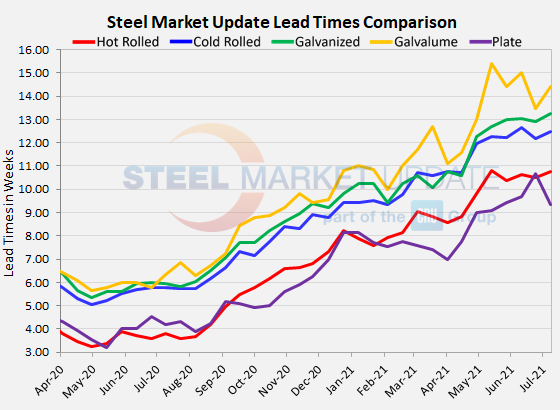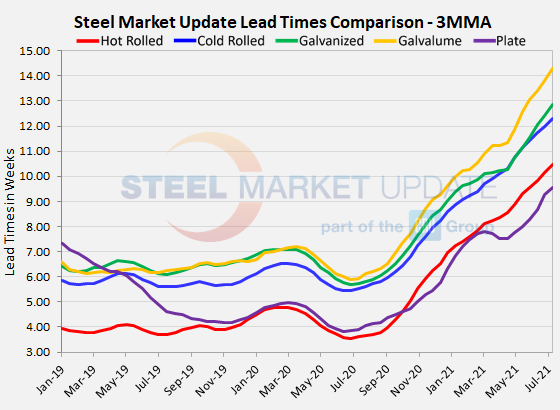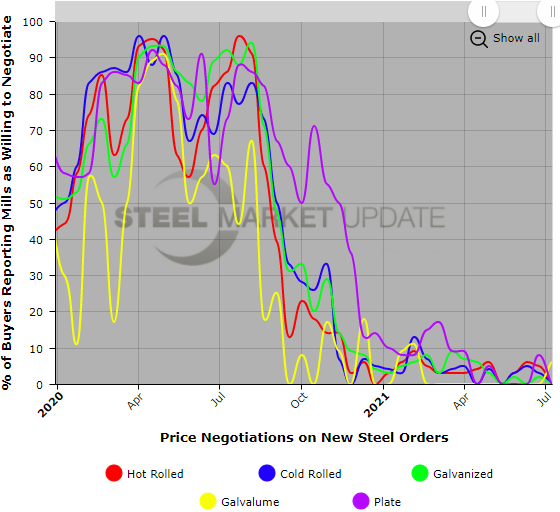SMU Data and Models

Mill Lead Times/Negotiations: Flat Rolled Inches Higher Again
Written by Tim Triplett
June 24, 2021
As it turns out, the slight downturn seen in steel mill lead times last month was not the beginning of a trend change. Lead times for all products but plate have inched higher in the last two weeks, indicating no relief yet from the tight supplies that continue to push steel prices higher.
According to SMU’s check of the market this week, lead times for hot rolled now average 10.74 weeks, up slightly from 10.50 weeks in the last survey. Cold rolled lead times rose to 12.46 weeks from 12.18. At 13.26 weeks, lead times for galvanized products bumped up from 12.92 weeks late last month. Lead times for spot orders of Galvalume have stretched to 14.42 weeks from 13.45.
Bucking the trend in flat rolled products, plate lead times shortened by more than a week in the latest survey, declining to an average of 9.33 from 10.67 weeks in SMU’s last check of the market.

Flat-rolled lead times have been extending for the past year, based on three-month moving averages, which smooth out the weekly volatility. The 3MMA for hot rolled lead times now averages 10.48 weeks, cold rolled 12.29 weeks, galvanized 12.86 weeks, and Galvalume 14.28 weeks. Plate’s 3MMA has risen to 9.54 weeks.

Lead times for deliveries of spot orders from the mills are the longest they have ever been in the history of SMU’s data. To put the 10-week lead times for hot rolled in perspective, in the decade prior to the COVID pandemic last year, hot rolled lead times averaged around 4.0 weeks.
Negotiations
When buyers start reporting that the mills have begun negotiating on price, that will be a sure sign the market is turning. But there is no indication of that yet. Almost all of the respondents to this week’s survey confirmed that the mills are still unwilling to talk price to secure an order. And why should they when they can easily sell everything they make in a market that is short of supply. As one buyer commented: “We still aren’t seeing any spot tons available from the SDIs, Nucors and Cleveland-Cliffs of the world. They don’t have any true availability, so there’s nothing to negotiate on.”

By Tim Triplett, Tim@SteelMarketUpdate.com

Tim Triplett
Read more from Tim TriplettLatest in SMU Data and Models

SMU’s June at a glance
A look at SMU data for the month of June.

SMU Survey: Buyers’ Sentiment rebounds from multi-year low
Both of SMU’s Steel Buyers’ Sentiment Indices edged higher this week. Current Sentiment rebounded from a near five-year low, while Future Sentiment rose to a two-month high

SMU flat-rolled market survey results now available
SMU’s latest steel buyers market survey results are now available on our website to all premium members.

SMU Survey: Sheet lead times pull back after early-June blip, plate holds
Following the uptick seen two weeks ago, lead times eased this week for all four sheet products tracked by SMU, while plate lead times held steady, according to this week’s market survey.

SMU Survey: Pricing power abruptly shifts to steel buyers
The majority of steel buyers responding to our latest market survey say domestic mills are more willing to talk price on sheet and plate products than they were earlier this month. Sheet negotiation rates rebounded across the board compared to early June, while our plate negotiation rate hit a full 100%.
